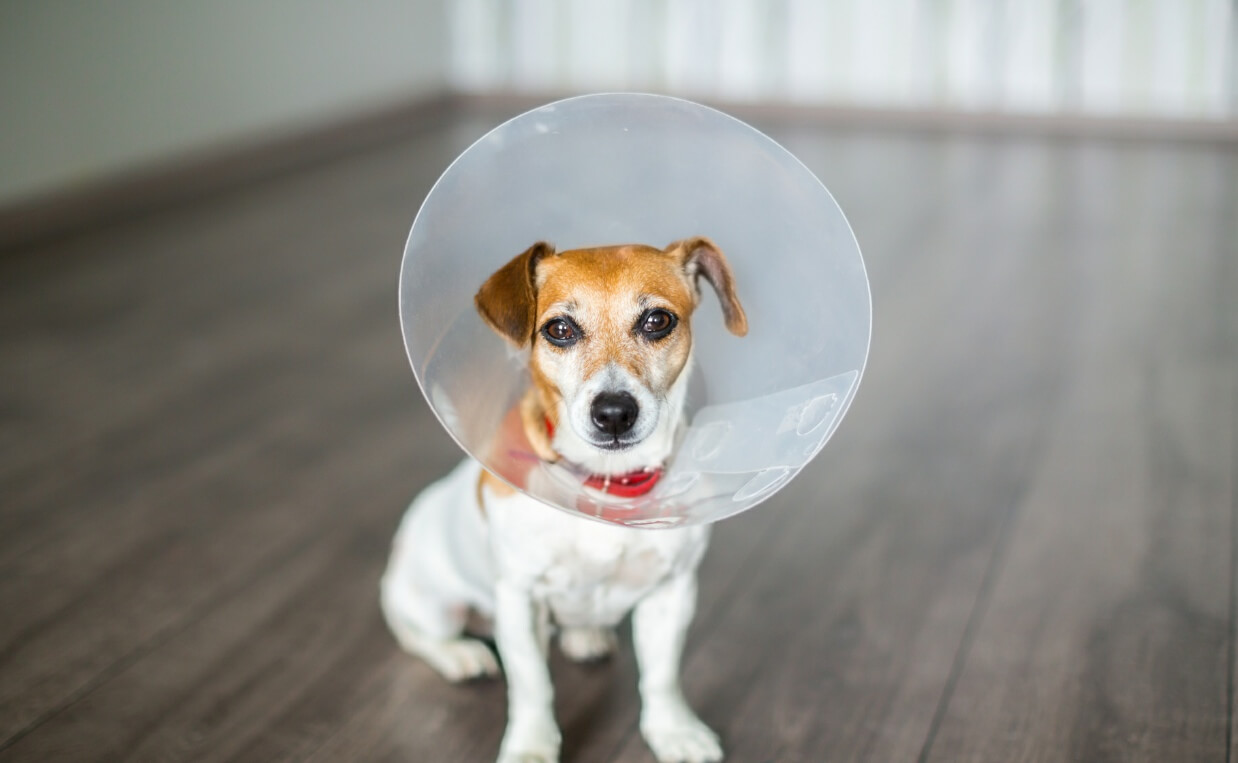
*Note: The term “neuter” applies to both sexes, while the term “spay” refers to females and “castrate” to male animals.
There is a great deal of controversy regarding if and when you should neuter your dog. Although many studies have been performed over the years to determine the benefits versus the risks of neutering your dog, many dog owners find the results to be confusing and somewhat inconclusive.
In today’s blog article, I am going to explore the pros and cons of neutering, backed by scientific research, so you can make your own informed decisions. My goal is to present both sides of the argument so you can determine what is best for your beloved pooch.
What Is Neutering?
Neutering is the process of removing all or part of an animal’s reproductive organs so he or she is unable to reproduce. Neutering is the most commonly preferred method for sterilization.
What is the Ideal Age for Neutering?
Most veterinarians recommend neutering your dog between six and nine months of age. The reason behind this is because at six months of age, pets are fully vaccinated and have matured to the point they react to anesthesia and surgery as an adult, reducing surgical risks substantially.

Pros of Neutering Your Dog
-
Prevent over-population of dogs
There is a huge problem of too many pets all around the world, which often results in pets needing to be put down when shelters are flooded and over capacity. Multiple studies have found sexually intact dogs and cats are more likely to be surrendered to shelter organizations than those who are neutered. This results in an estimated 1.5 million shelter animals being euthanized in the U.S. alone every year, according to the ASPCA.
The two main concerns here are: 1) the majority of surrendered animals are from unwanted litters and 2) should sexually intact dogs be adopted, they may reproduce and repopulate shelters again.
This problem is primarily due to irresponsible dog owners who do not have a sound knowledge of animal reproduction. Therefore, neutering unowned animals is an attempt to maintain proper dog population control.
-
Avoid sexual behavioral problems
Behavioral problems, known as sexually dimorphic behaviors, are one of the most common reasons pets are surrendered. These include behaviors like roaming, mounting and urine marking. Gonadectomy, which is the removal of the testes or ovaries, has been correlated with a decrease in the sexually dimorphic behaviors due to the gonadal steroid hormone.
Sexual behaviors in male dogs, such as mounting, pelvic thrusting, urine marking, roaming and intermale aggression, for example, makes them undesirable and unsafe to be kept as household pets. Castration is therefore beneficial to remove these behaviors and make them more tolerated by dog owners. One large-scale study of over 1,800 dogs also revealed a decrease in separation anxiety and submissive urination associated with gonadectomy performed before dogs were five months of age.

-
Mammary gland tumors
Mammary gland tumors are the most common tumors of female dogs. They are extremely malignant, which means they can easily spread to other organs, especially the lungs, which often results in the animal being put down on diagnosis. Maintenance of a sexually intact status is a major risk factor for the development of mammary gland tumors, of which the risk increases substantially with age.
One study found that sexually intact dogs have seven times greater risk of developing mammary gland tumors when they get older compared to spayed dogs.
-
Pyometra
Pyometra is an infection of the uterus. Pyometra has the potential to become fatal if left untreated. It is highly prevalent in all intact female dogs, but can be treated successfully with an ovariohysterectomy.
-
Benign prostatic hypertrophy-hyperplasia (BPH)
BPH is a very common condition in older, sexually intact male dogs, which predisposes them to prostatitis, which is a very painful condition that can lead to constipation and painful urination. Once again, castration is a key factor in the treatment and prevention of BPH in dogs.
-
Testicular tumors
Testicular tumors are the second most common tumor type in male dogs, and even though they have a low rate of malignancy, castration is curative.

-
Ovarian and uterine tumors
Ovarian and uterine tumors in dogs are uncommon and metastasis is very rare, but once again, spaying is curative in most situations.
-
Increased lifespan
Several studies have revealed an increase in lifespan for gonadectomized dogs when compared with sexually intact animals. This may be a reflection of enhanced care of animals by owners who made the investment of surgery, or a decrease in risk associated behaviors, such as roaming in intact animals.
Cons of Neutering Your Dog
-
Surgical complications
As with any surgical procedure, the immediate concerns of neutering include the usual anesthetic and surgical complications, such as bleeding, infection and death. These risks are relatively low in routine neutering, however, they can be increased in some animals due to other pre-existing health factors.
-
Urinary tract disorders
Spayed female dogs may have an increased risk of developing urinary tract infections and juvenile or recessed vulvas when spayed before puberty.
Urinary mechanism sphincter incompetence, also known as estrogen responsive urinary incontinence, is a common problem in female dogs spayed before three months of age. This is a multi-factorial problem also influenced by breed, body size, obesity, hormones and the urethral anatomy. Luckily, urinary incontinence can be easily controlled with medical treatments.

-
Obesity
Obesity is the most common nutritional disorder in dogs, and gonadectomy is commonly reported to be a risk factor for obesity. Estrogen may act as a satiety factor which would explain the increase in appetite and resulting food intake in spayed females. Obesity is also a multi-factor problem though, and is also influenced by breed, age, housing, ownership and gender.
-
Hip dysplasia
Timing of the closure of growth plates in long bones is, in part, controlled by gonadal hormones in dogs. Gonadectomy at any age before the closure of these growth plates delays closure and is associated with the lengthening of these long bones. Hip dysplasia is a hereditary condition in dogs affecting both sexes, but it is more prevalent in large and giant breed dogs. One large study revealed there was an increase in incidence of hip dysplasia in dogs neutered before five months of age.
-
Cranial cruciate ligament (CCL) rupture
CCL rupture is more prevalent in gonadectomized male and female dogs than sexually intact dogs, but it also has a large hereditary component, which is also influenced by body weight and body condition score.
-
Osteosarcoma
Osteosarcoma is a highly malignant tumor of which the risk of development increases with age and body weight. One popular study investigated close to 700 purebred Rottweiler dogs and found a significant increase in incidence of osteosarcoma in both male and female dogs that had undergone gonadectomy before one year of age. However, the overall incidence of osteosarcoma within this population of dogs was much higher than the general population of dogs, which suggests a hereditary component.

-
Hemangiosarcoma
Hemangiosarcoma is the most common cardiac tumor in dogs and gonadectomized animals are an increased risk of developing both splenic and cardiac hemangiosarcoma, compared to their intact counterparts.
-
Transitional cell carcinoma
Research shows gonadectomized dogs have an increased risk of development of TTC approximately three times more often than sexually intact animals.
-
Prostatic neoplasms
Gonadectomized dogs are, on average, three times more likely to develop prostatic cancer compared to sexually intact male dogs, according to research studies. These tumors are also very malignant, often metastasizing to bones.
-
Hypothyroidism
Some studies have revealed an increased risk of development of hypothyroidism in spayed females and castrated males. However, hypothyroidism is easily controlled with medical management.
-
Pancreatitis
Spayed females have an increased risk of developing fatal acute pancreatitis as compared with intact females, as reported by research studies.
Read more: Pancreatitis in Dogs – Symptoms, Causes and Treatment

-
Increased adverse reactions to vaccines
The risk of developing an adverse reaction to vaccines is 27 to 38 percent greater in neutered dogs as compared to intact, as reported by research.
-
Un-neutered males not allowed to co-mingle at Canine Campus
Another thing to keep in mind is un-neutered males over 7-months of age are not allowed to co-mingle on campus, which means he will not be able to play with the rest of the pack. This is an important consideration as there are many social and mental benefits for dogs to enjoy the playgroup experience here at Canine Campus.
Reliability of Research
The truth is the majority of these studies are far from definitive and therefore should be evaluated with a critical eye. The three main reasons for this include:
-
Retrospective studies
These are retrospective studies instead of prospective studies. Retrospective studies are based on historical clinical cases which carry the risk of missing important information.
-
Correlation does not imply causation
Most of these studies have not definitely proven the results and the claims are therefore only based on hypotheses. Even though they may have some reasonable and sensible explanations, the evidence is circumstantial at best.
-
Questionable statistical methods
The statistical methodology for establishing causal relationship is questionable. Most of these studies use very small sample sizes which could lead to statistically significant results, even if there isn’t one. Also, the way the results are calculated are often subject to a built-in selection bias. Further research will need to be conducted in statistically significant methods in order to validate these conclusions.

Should You Neuter Your Dog or Not?
There are a lot of pros and cons in the “should I neuter my dog” debate. So how are dog parents supposed to know what is best for their pup?
In reality, you will need to assess each pro and con as they relate to your dog. For most dog parents, it comes down to choosing the lesser of two evils based on hereditary conditions, ethical values and the ability to spend quality time in canine playgroups.
Each dog is an individual; the benefits and detriments of neutering should be examined carefully for your dog. If you decide not to neuter your dog, please understand you will need to fully commit to containing your dog properly in order to prevent them from adding to the mass pet overpopulation problem.
The internet is full of easy-to-access information, and in today’s digital world, it is easy to be misled by false, exaggerated claims and statements. This is why it is important to trust reliable, scientific-backed sources.
Did you decide to spay or castrate your dog? If so, why did you make the decision you did? Please weigh in with your thoughts in the comments below. Remember to keep your comments respectful and appropriate. Thank you.

 What is Distemper in Dogs and How Is It Treated?
What is Distemper in Dogs and How Is It Treated? 9 Common Eye Issues in Dogs
9 Common Eye Issues in Dogs Is RoundUp Weed Killer Safe for Dogs?
Is RoundUp Weed Killer Safe for Dogs? How to Recognize and Manage Arthritis in Dogs
How to Recognize and Manage Arthritis in Dogs 10 Ways to Keep Your Dog Safe During the Fourth of July
10 Ways to Keep Your Dog Safe During the Fourth of July






Leave a Reply